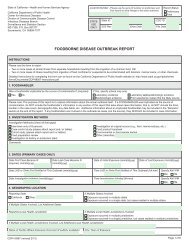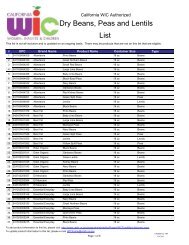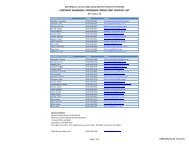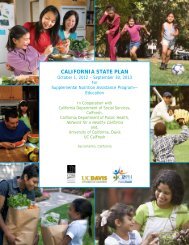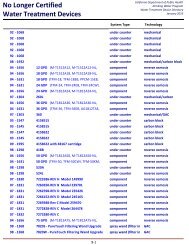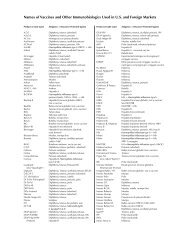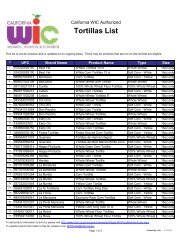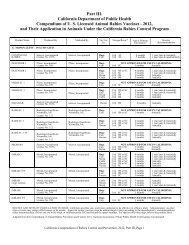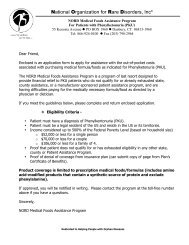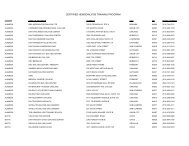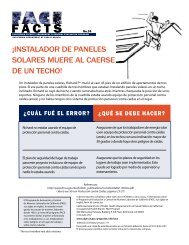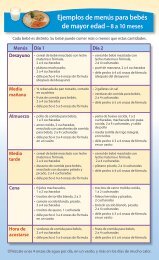OTIS Evaluation Guide (PDF) - California Department of Public Health
OTIS Evaluation Guide (PDF) - California Department of Public Health
OTIS Evaluation Guide (PDF) - California Department of Public Health
Create successful ePaper yourself
Turn your PDF publications into a flip-book with our unique Google optimized e-Paper software.
How many waves <strong>of</strong> the survey will be conducted?<br />
This depends on the needs <strong>of</strong> your objective. The purpose <strong>of</strong> two or more waves is to compare responses at<br />
different points in time, such as before and after an intervention, in order to determine if it made a difference<br />
in their attitude, knowledge, and/or behavior.<br />
How will the sample be selected?<br />
Most likely, the sample will be all the participants, unless the number <strong>of</strong> participants is too large (e.g., more<br />
than 500 tobacco retailers in a very large county). In the case <strong>of</strong> a large number <strong>of</strong> participants, a random<br />
sample should be used.<br />
How many will be in the sample?<br />
It will be either the total number <strong>of</strong> participants or a sample <strong>of</strong> a large number <strong>of</strong> participants.<br />
What is the primary method in which the survey will be conducted?<br />
In many cases, the survey can be conducted on-site immediately after the intervention. For educational<br />
activities that do not have face-to-face contact, surveys can be mailed to the participants, but you should be<br />
prepared for a low response rate.<br />
How will the results be analyzed and interpreted?<br />
The analysis <strong>of</strong> an education/participant survey will probably be quantitative (e.g. measurable, numbered)<br />
in nature. However, if you also include open-ended questions, it can allow you to get a better idea <strong>of</strong> their<br />
thoughts and opinions (qualitative data). A pre- and post-survey is highly desirable because you can detect<br />
the immediate difference on attitude and intention as a result <strong>of</strong> your intervention. It is important to keep in<br />
mind that these results describe important program attributes, but they are not the outcome for your objective.<br />
Statistical analysis should be performed to see if there is a difference between responses before and after the<br />
intervention/education activity. The findings can add to your understanding <strong>of</strong> the quality <strong>of</strong> the intervention/<br />
education efforts and sometimes can demonstrate the progress <strong>of</strong> the program.<br />
5. Policy Record (Formerly called “City or County Council” form)<br />
The questions in the “Policy Record ” form can be seen in Figure 32.<br />
What is the topic <strong>of</strong> the policy record you are collecting?<br />
Obviously you are interested in, and will want to collect, all <strong>of</strong>ficial records and reports <strong>of</strong> member voting or<br />
discussion related to your policy objective.<br />
How will findings from the policy record be analyzed?<br />
A thorough content analysis should be conducted. This analysis, along with the findings from your other homework,<br />
can be used by your coalition to identify who or what special interest groups may oppose or be behind<br />
the opposition <strong>of</strong> the passage <strong>of</strong> the ordinance. Sometimes these results identify the messages or intervention<br />
activities that have not yet had an impact, and they can prompt you to investigate “why?”<br />
How will the policy record be used to advance your objective?<br />
If any policy record collection is conducted in the middle or early stage <strong>of</strong> your funding cycle, you may use<br />
the analysis results to modify or generate new intervention strategies. The challenge is to make sure that the<br />
<strong>OTIS</strong> <strong>Evaluation</strong> <strong>Guide</strong> • March 2007<br />
105



